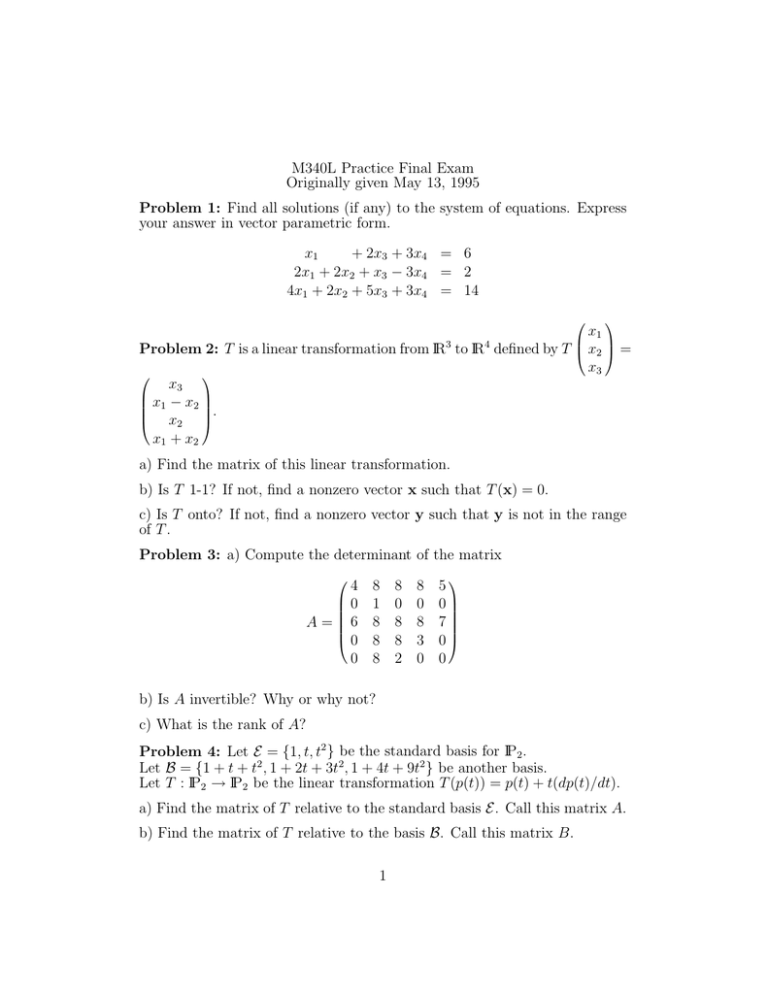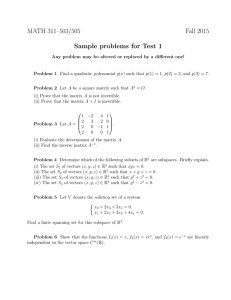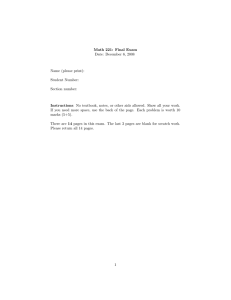M340L Practice Final Exam Originally given May 13, 1995
advertisement

M340L Practice Final Exam
Originally given May 13, 1995
Problem 1: Find all solutions (if any) to the system of equations. Express
your answer in vector parametric form.
x1
+ 2x3 + 3x4 = 6
2x1 + 2x2 + x3 − 3x4 = 2
4x1 + 2x2 + 5x3 + 3x4 = 14
x1
3
4
Problem 2: T is a linear transformation from IR to IR defined by T x2 =
x3
x3
x − x
1
2
.
x2
x1 + x2
a) Find the matrix of this linear transformation.
b) Is T 1-1? If not, find a nonzero vector x such that T (x) = 0.
c) Is T onto? If not, find a nonzero vector y such that y is not in the range
of T .
Problem 3: a) Compute the determinant of the matrix
4
0
6
A=
0
0
8
1
8
8
8
8
0
8
8
2
8
0
8
3
0
5
0
7
0
0
b) Is A invertible? Why or why not?
c) What is the rank of A?
Problem 4: Let E = {1, t, t2 } be the standard basis for IP2 .
Let B = {1 + t + t2 , 1 + 2t + 3t2 , 1 + 4t + 9t2 } be another basis.
Let T : IP2 → IP2 be the linear transformation T (p(t)) = p(t) + t(dp(t)/dt).
a) Find the matrix of T relative to the standard basis E. Call this matrix A.
b) Find the matrix of T relative to the basis B. Call this matrix B.
1
c) Write down the change-of-basis matrix from B to E. Call this matrix P .
d) Write an equation expressing B in terms of A and P .
Problem 5: The following matrices are row-equivalent:
1
1
A=
1
2
1 5
2 7
3 9
4 14
1 8
0 7
,
0 10
1 18
1
0
B=
0
0
0
1
0
0
3
2
0
0
0
0
1
0
1
3
4
0
a) Find a basis for the row space of A.
b) Find a basis for the column space of A.
c) Find a basis for the null space of A.
Problem 6: Consider the matrix
1 0 2
A = 0 3 0
−2 0 1
a) Find all the real eigenvalues of A and the corresponding eigenvectors.
b) Find all complex eigenvalues and corresponding eigenvectors of A.
c) Find an invertible matrix P and a diagonal matrix D such that A =
P DP −1. [Warning: P and D may not be real].
Problem 7: In contrast to predator-prey relationships, it can sometimes
happen that two different kinds of animals actively help each other. This is
called symbiosis. Since I can’t think of any realistic examples, I’ll illustrate
with mythical animals.
Griffins and Dragons live in the Enchanted Forest. Dragons can live without griffins, but griffins cannot live without dragons. The number of dragons
D and griffins G in the forest each year is determined by the populations the
previous year, according to the formulas:
Dk+1 = 1.5Dk + Gk ,
Gk+1 = Dk
The eigenvalues of the matrix
eigenvalues (2, 1) and (1, −2).
1.5 1
1 0
2
are 2 and −.5, with corresponding
a) If in year 0 there are 25 dragons and no griffins, what will the populations
be in year k? (Don’t worry about your answers being fractional. Mythical
animals don’t have to come in whole units).
b) In the long run, will the populations grow, shrink, or approach a nonzero
equilibrium value?
c) After a long time, approximately what will the ratio of dragons to griffins
be?
Problem 8: Let W be the subspace of IR4 spanned by the vectors (1, 1, 1, 1)T ,
(1, 2, 2, 3)T , and (5, 7, 7, 9)T .
a) What is the dimension of W ?
b) Find an orthonormal basis for W .
Problem 9: Let W be the subspace of IR4 spanned by u1 = (1, 0, 1, 0)T and
u2 = (4, 3, −4, 3)T . (Note that u1 and u2 are orthogonal).
a) Find the orthogonal projection of the vector (3, 0, 3, 5)T onto the plane
W.
b) Find the distance from W to the point (3, 0, 3, 5).
b) Find a least-squares solution to the system of equations
1 4
3
0
3 x1
0
=
1 −4 x2
3
0 3
5
Problem 10. True of False
a) A 6 × 5 matrix cannot have a pivot position is every row.
b) Let v1 , v2 and v3 be vectors in IR3 . If none of these vectors is a multiple
of one of the others, then the set is linearly independent.
c) If a system Ax = b has more than one solution, then Ax = 0 has more
than one solution.
d) If AB = BA and A is invertible, then A−1 B = BA−1 .
e) If AB = 0, then either A = 0 or B = 0.
f) For every real matrix A, det(AT A) ≥ 0.
g) Let S be a set of vectors in a vector space V . If Span(S) = V , then a
3
subset of S is a basis for V .
h) A change-of-basis matrix is always invertible.
i) If a square matrix A is diagonalizable, then its columns are linearly independent.
j) If W is a subspace of IRn , then W and W ⊥ have no nonzero vectors in
common.
4





